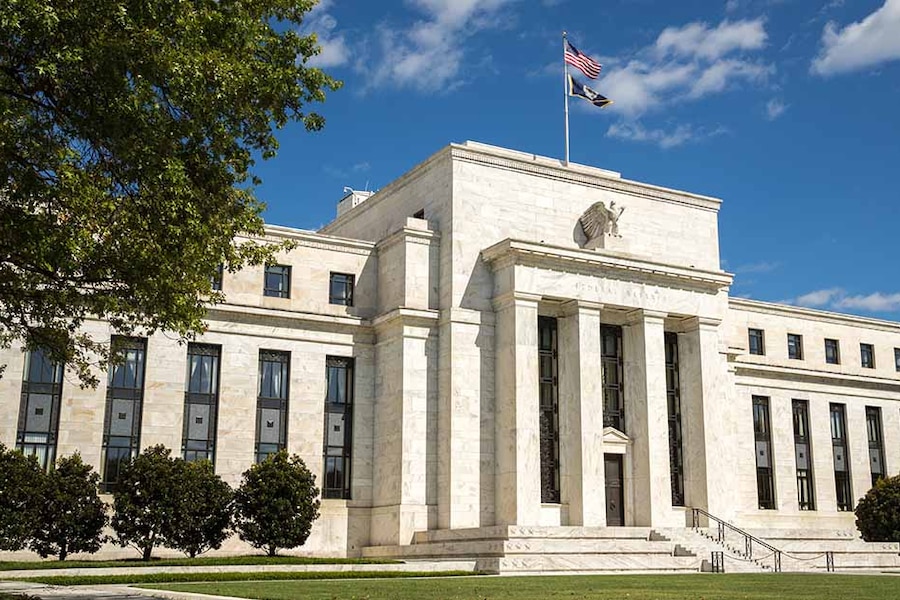Fed Holds Steady, Cites "Elevated Uncertainty"

The Federal Open Market Committee (FOMC) kept interest rate policy unchanged at its March meeting and continued to signal the potential for two rate cuts later this year, which would bring the federal funds rate down to a range of 3.75% to 4.0% from its current range of 4.25% to 4.5%.
The lack of change in the policy rate was expected, but the updated projections indicate that the Fed sees a mildly "stagflationary" outlook, with slower economic growth and higher inflation—historically an undesirable combination.
The accompanying FOMC statement highlighted the uncertainty about the outlook, noting that it is "unusually elevated" due to myriad changes in policies by the Trump administration, citing tariffs, immigration limits and tax policy. Fed Chair Jerome Powell indicated that the committee was focusing on evaluating the effects of the range of potential policies and was in "no hurry" to change policy.
Lower growth and stubborn inflation
In the Fed's latest quarterly Summary of Economic Projections, the median gross domestic product (GDP) growth projection was lowered across the board for the next three years, with the economy projected to grow by 1.7%, 1.8%, and 1.8% from 2025 through 2027, respectively. The median projection was previously at 2% or higher for the next two years.
Meanwhile, inflation projections were revised higher at both the headline and core (excluding food and energy prices) level. The core personal consumption expenditures (PCE) index, the Fed's preferred inflation benchmark, is projected to rise by 2.8% this year compared to the previous projection of 2.5%—a notable upward revision. The labor market projection only weakened modestly, with the unemployment rate projected to end the year at 4.4% compared to the 4.3% that had been expected at the December 2024 meeting.
Economic projections

Source: Federal Reserve Board, 3/19/2025.
Notes: For each period, the median is the middle projection when the projections are arranged from lowest to highest. When the number of projections is even, the median is the average of the two middle projections. The central tendency excludes the three highest and three lowest projections for each variable in each year. The range for a variable in a given year includes all participants' projections, from lowest to highest, for that variable in that year. Longer-run projections for Core PCE are not collected.
With inflation stalled above the Fed's 2% target and the unemployment rate projected to stay low, the Fed had little reason to adjust policy at this meeting. Moreover, there are risks associated with potential U.S. government policies on tariffs, immigration, and taxes that could possibly push up inflation and/or slow growth. Staying in wait-and-see mode is viewed as a reasonable compromise when policies are pulling in different directions. Given the cross currents facing the economy, we do not expect a change in interest rate policy from the Fed until later this year, if at all.
Inflation is still above the Fed's 2% target

Source: Bloomberg.
Monthly data from 1/31/2015 to 1/31/2025. which is the most recent data available. Dotted lines represent 2026 and 2027 FOMC projections, 3/19/2025.
PCE: Personal Consumption Expenditures Price Index (PCE DEFY Index), Core PCE: Personal Consumption Expenditures: All Items Less Food & Energy (PCE CYOY Index), percent change, year over year.
The projections for the federal funds rate in the "dot plot" still show a median estimate among the Fed members for two rate cuts this year, but there was an upward move in some of the dots compared to the December projections. There are now eight members of the Fed projecting one or no cuts this year. It's also noticeable that there was a wide dispersion around the longer-run estimate for the federal funds rate. It highlights the uncertainty surrounding the outlook for Fed policy.
Fed members are still projecting two rate cuts this year

Source: Bloomberg, as of 3/19/2025.
Forecasts contained herein are for illustrative purposes only, may be based upon proprietary research and are developed through analysis of historical public data.
The Fed also announced that it was lowering the cap on the run-off of its balance sheet to $5 billion per month from $25 billion for U.S. Treasuries, while maintaining the $35 billion per month cap on agency debt and agency mortgage-backed securities. The balance sheet has already declined by over $2 trillion and is nearing a sustainable level. With the impact of the debt ceiling limit on the Treasury's General Account, the Fed wants to make sure there are ample reserves in the banking system.
Cut, hold steady or hike in the future?
We expect the Fed to hold policy steady for the foreseeable future. Powell emphasized the heightened uncertainty around its policy. He went so far as to say "I don't know anyone who is confident of their forecast." He indicated that the Fed was watching and evaluating the data to assess the implications for the economy.
Bond yields declined moderately during Powell's news conference. He indicated that while survey-based inflation expectations have risen for both businesses and consumers, market-based readings on long-run inflation expectations remained "well anchored." That was reassuring to the markets.
Overall, the outcome of the FOMC meeting doesn't appear likely to have a major impact on Treasury yields in the near term. Longer term, we believe yields are more likely to fall than rise significantly, due to our expectations for slowing economic growth. However, for the time being, we continue to suggest that investors keep average duration in portfolios near benchmark levels. Intermediate-term high-credit-quality bonds with yields in the 4.5% to 5.0% can make sense for a core fixed income allocation for many investors.